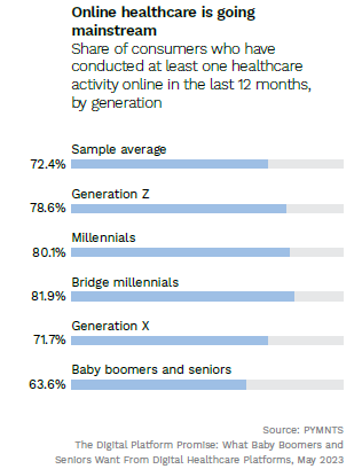Telehealth Goes Mainstream as 6 in 10 Boomers Embrace Trend

The healthcare industry is undergoing a digital transformation, with telehealth services gaining popularity among consumers of all ages. Even baby boomers, often stereotyped as resistant to technology, are embracing the trend, according to findings from a PYMNTS Intelligence research study.
In fact, contrary to stereotypes, the joint PYMNTS-Lynx study shows that 64% of baby boomers and seniors are actively engaging with digital healthcare activities. Nearly two-thirds of this demographic have also participated in digital healthcare activities in the past year, indicating their openness to using technology for managing their medical services and benefits.
The survey further reveals that baby boomers and seniors report higher satisfaction rates for digital healthcare experiences compared to the average consumer when it comes to key activities such as scheduling appointments, accessing digital pharmacies and refilling prescriptions online. This suggests that older individuals not only embrace digital channels but also find value in them, challenging the notion that they are resistant to technology.
Moreover, baby boomers and seniors have a strong interest in using unified digital platforms to manage their healthcare experiences. These platforms offer a range of functionalities, including making payments, interacting with providers and insurers, managing prescriptions, and accessing detailed benefit information. The convenience and accessibility of these platforms are what appeal to older consumers, who typically have greater healthcare needs and expenses.
Still, younger generations are at the forefront compared to their older counterparts in adoption of the online healthcare trend. In the past year, 82% of bridge millennials, 80% of millennials, and 79% of Generation Z consumers engaged in at least one healthcare-related task online. This pattern is closely trailed by 72% of Generation X consumers, underscoring that the transition of healthcare tasks to digital platforms is becoming mainstream, encompassing all age groups.

As further evidence of digital healthcare going mainstream, Amazon announced last month that it will begin offering Prime members access to virtual healthcare services through One Medical, an Amazon-owned company.
According to the release, the One Medical membership offers unlimited, nationwide access to round-the-clock virtual healthcare, including video consultations with healthcare providers and an in-app “Treat Me Now” feature that offers quick care for rapid treatment for common health issues. Additionally, Prime members residing close to a One Medical facility can schedule remote or in-person appointments for the same or next day.
“When it is easier for people to get the care they need, they engage more in their health and realize better health outcomes,” Neil Lindsay, senior vice president, Amazon Health Services, said in a Nov. 8 news release.
Amazon’s expansion into telehealth through One Medical aligns with the projected growth of the global telehealth market, which is expected to grow from $84 billion in 2022 to reach $450 billion by 2032, according to a report by Emergen Research, per PYMNTS. This strategic move positions Amazon to capture a significant share of this burgeoning market and reinforces the presence of telehealth in the mainstream market.
Moving forward, the convenience and accessibility offered by telehealth services will likely continue to attract a growing number of individuals, including baby boomers and seniors, further increasing its adoption across diverse age groups.

